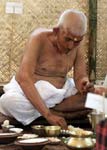|
Religions
in Nepal |
|
The
Hindu caste system |
 |
Although
the caste system was abolished by law in 1949, it remains a significant
force throughout India.
Each
follower of Hinduism belonged to one of the thousands of Jats (communities)
that existed in India. The Jats were grouped into four Varna (social castes),
plus a fifth group called the "untouchables." A person's Jat determined
the range of jobs or professions from which they could choose. Marriages
normally took place within the same Jat. There were rules that prohibited
persons of different groups from eating, drinking or even smoking with
each other. |
|
People
were once able to move from one Varna to another. However, at some time
in the past (estimates range from about 500 BCE to 500 CE), the system
became rigid, so that a person was generally born into the Jat and Varna
of their parents, and died in the same group. "The caste system splits
up society into a multitude of little communities, for every caste, and
almost every local unit of a caste, has its own peculiar customs and internal
regulations."
The
Rigveda defined four castes. In decreasing status, they are normally:
|
Brahmins (the priests and academics) |
|
Kshatriyas (rulers, military) |
|
Vaishyas (farmers, landlords, and merchants) |
|
Sudras (peasants, servants, and workers in non-polluting jobs). |
|
|
The
Dalit - The casteless people |
The
Dalit were outcasts who did not belong to one of the castes. Until the
late 1980's they were called Harijan (children of God). They worked in
what are considered polluting jobs. They were untouchable by the four castes;
in some areas of the country, even a contact with their shadow by a member
of the Varnas was considered polluting.
Practicing
untouchability or discriminating against a person because of their caste
is now illegal. The caste system has lost much of its power in urban areas;
however it is essentially unchanged in some rural districts. The government
has instituted positive discrimination in order to help the Dalit and lower
castes. Many Dalit have left Hinduism in recent years. This has sometimes
been motivated by a desire to escape the caste system.
|


